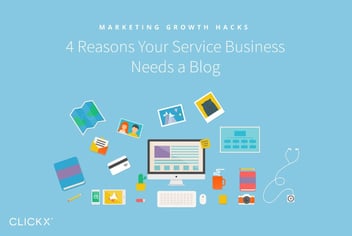7 Social Media Mistakes Every Small Business Needs to Avoid
Having a solid social media presence can be a boon for your business. In fact, many local firms rely on social media alone to generate new leads.
Unfortunately, a lot of small business owners are making mistakes that are killing their social media strategies—and any growth potential that it might bring.
In this article we’re going to address the seven most common social media mistakes most small business owners make, and what you can do to remedy these issues.
Let’s start digging into the details!

1. Failing to Experiment With Content Types
[Tweet “You must constantly delight your followers if you want them to stick around.”]
Most people use social media to keep in touch with their friends and maintain other personal connections. As a business, you’re going to have to work extra hard to attract attention and form a meaningful relationship in this context.
The best way to do this is to consistently provide value to your followers through your content.
A lot of companies share the same style of content across every social media platform. This can lead to boredom, and lack of engagement, on behalf of your visitors. Different platforms demand different content types, so it’s useful to experiment until you come across a content type that aligns with your audience and your goals.
Change things up and experiment with different images, infographics, short videos, long and short copy, and different types of questions.
2. You’re Only Posting When You Have the Time
In order to have a great social media presence, you’re going to need to put in the work. A blossoming social presence doesn’t happen with just a few tweets and posts here and there. Social media may seem simple, but it does take time and effort.
This is why a lot of companies outsource their social media management. After all, it’s a lot of work to respond to customer comments, monitor your feeds, and consistently create new content.
Create a social media schedule that works for you, and stick to it.
3. Failing to Implement Tracking
The only way to see if what you’re doing is working is by implementing tracking.
The only way to truly know what’s working is to track your posts. By tracking your posts, you’ll be able to see if you’re reaching your goals and metrics. For example, one of your images may perform ten times better than another, but you’ll have no way of knowing that unless you’re actively monitoring results.
According to Social Media Examiner, less than a quarter of companies actively keep track of what’s working across social media. Even a simple tool like Google Analytics will give you basic data to see if your activity on social media is generating traffic for your website.
4. Focusing on Promotion Over Value
The whole point of your business having a social media strategy is to build your brand. However, it can be easy to get caught in the trap of promoting your business too often. Even when you truly believe in what your company does, you need to be careful this doesn’t influence what type of content you post.
Different social media networks have different expectations. For instance, LinkedIn is more promotional in nature, while Twitter is commonly likened to a cocktail party.
You must have your audience in the forefront of your mind before you post anything. Customers today are wary of companies that pitch their services too frequently. Make sure your posts offer more than a cleverly disguised sales pitch.
5. Spreading Yourself Too Thin
It can be easy to spread yourself too thin across social media. There are literally hundreds of networks to choose from. Luckily, most of these won’t be in alignment with your business.
Start with one or two networks and expand from there. Only expand once you’ve built a significant following and are seeing returns on your efforts.
As mentioned above, growing a social media presence and maintaining engagement is a lot of work. Having a consistent posting schedule is important for building your following.
Opinions vary on what the optimum amount of times to post are but around two to three times per day on a regular basis is a good guideline.
Bear in mind that the key point is quality and value to your readers rather than overall frequency statistics so but be careful not to spam. Posting too often will simply flood your followers feed with your posts, and they’ll get tired of you. Try to find the happy medium that keeps your followers engaged, and doesn’t wear you out.
The infographic from Buffer below has some useful guidelines per social channel:
6. Forgetting to Engage With Your Followers

Zappos does an incredible job with customer engagement.
Social media is an incredible way to have real-time conversations with your customers and followers. If you post on a regular basis but fail to interact with the comments and messages your posts receive, then you’re doing your business a disservice. A high percentage of customers who post on social media expect a response within the hour.
The ripple effect of replying to one of your followers goes way beyond simple brand management. It can actually make your customers’ day. It takes a lot of time to engage with your fans, but it’s time well spent. By focusing on building relationships, you’ll see your word of mouth marketing results start to grow.
Remember, nothing is better for your business than a happy customer base.
7. Not Using Other Management Tools
Managing all of your social media accounts can be a very time-consuming process. Luckily, there is a host of social media management tools that can help you stick to your various posting schedules.
A few of the most common tools include Hootsuite, Buffer, and Sprout Social. These tools enable you to schedule your content, track the results of your campaigns, and have other team members keep tabs on your social media posts.
However, one caveat of using these tools is to not have them control every part of your social media strategy. Your customers will be able to tell if you’re not actually engaging and instead letting a tool do all the work. Automation can be useful, but make sure you add a human touch every now and then.
Bonus Mistake: Paying for Likes or Followers
A big mistake a lot of business owners make is paying for likes or followers. It’s smart to invest money into some parts of your marketing strategy such as paid advertising. Paying to boost your number of likes or follower count, on the other hand, will only damage your business in the long run.
It might give you a temporary ego boost, but you’ll tend to find decreasing engagement levels as the followers you bought aren’t going to be contributing members of your community. Instead of trying to give off the illusion you have a large and engaged following, spend time nurturing and building this audience yourself.
Building great things takes time. But, once you have a community on social media that supports you and consistently generates new leads, you’ll start to see the value.
Conclusion
Social media can be a very powerful tool for your business. To truly unlock its potential you must avoid any of the pitfalls we mentioned above. When executing any social media strategy it’s important to remember that social media is a long-term game, just like anything in business.
Focus on delighting and serving your fans above all else, and you’ll start to see your engagement levels rise and new bonds start to form.
Any common social media mistakes we missed? Feel free to continue the conversation with us via Facebook or Twitter or hit us up in the comments!





.png?width=352&name=Weighing-Up-the-Costs-3-Ways-to-Measure-Your-Business-Web-Marketing-ROI-1040%20%C3%97%20700-c%20(1).png)
